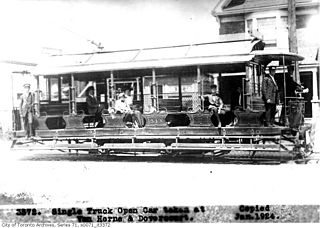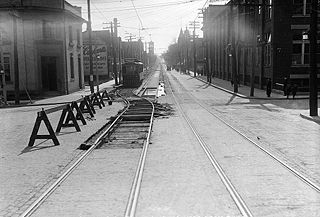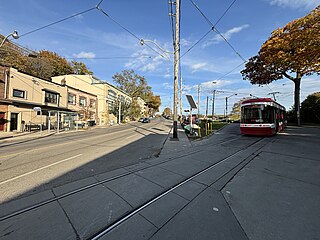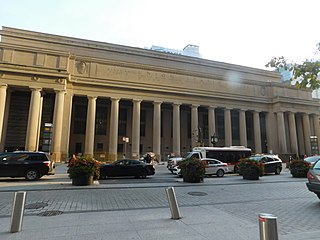
The Toronto Transit Commission (TTC) is the public transport agency that operates bus, subway, streetcar, and paratransit services in Toronto, Ontario, Canada, some of which run into the Peel Region and York Region. It is the oldest and largest of the urban transit service providers in the Greater Toronto Area, with numerous connections to systems serving its surrounding municipalities.

The Hamilton Street Railway (HSR) is the public transport agency for Hamilton, Ontario. The name is a legacy of the company's early period, when public transit in Hamilton was primarily served by streetcars. Although streetcars are no longer used in the city today, the HSR operates bus and paratransit services, with a ridership of 21 million passengers a year.

The Toronto Railway Company (TRC) was the operator of the streetcar system in Toronto between 1891 and 1921. It electrified the horsecar system it inherited from the Toronto Street Railway, the previous operator of streetcar service in Toronto. The TRC was also a manufacturer of streetcars and rail work vehicles, a few of which were built for other streetcar and radial operators.

The Toronto streetcar system is a network of eleven streetcar routes in Toronto, Ontario, Canada, operated by the Toronto Transit Commission (TTC). It is the third busiest light-rail system in North America. The network is concentrated primarily in Downtown Toronto and in proximity to the city's waterfront. Much of the streetcar route network dates from the 19th century. Three streetcar routes operate in their own right-of-way, one in a partial right-of-way, and six operate on street trackage shared with vehicular traffic with streetcars stopping on demand at frequent stops like buses. Since 2019, the network has used low-floor streetcars, making it fully accessible.

The history of public transportation in Toronto in Canada dates back to the middle 19th century under many different private companies, organizations and owners, which were all later unified as a single government-run entity during the 1920s.

The 511 Bathurst is a Toronto streetcar route operated by the Toronto Transit Commission in Ontario, Canada.
The 2006 Toronto Transit Commission wildcat strike was an unlawful strike in Toronto, Ontario, Canada, that occurred on May 29, 2006. It was initiated by 800 Toronto Transit Commission mechanical and janitorial workers who were protesting proposed changes in work schedules, including permanent reassignment of 100 workers to night shifts.
The Steel Workers Organizing Committee (SWOC) was one of two precursor labor organizations to the United Steelworkers. It was formed by the CIO on June 7, 1936. It disbanded in 1942 to become the United Steel Workers of America. The Steel Labor was the official paper of SWOC.

The New Orleans general strike was a general strike in the U.S. city of New Orleans, Louisiana, United States, that began on November 8, 1892. Despite appeals to racial hatred, black and white workers remained united. The general strike ended on November 12, with unions gaining most of their original demands.
Most Toronto Transit Commission personnel are members of the Amalgamated Transit Union Local 113. Total membership (2016) is approximately 10000 members. The ATU has represented Toronto Transit Commission (TTC) workers since 1899; workers of predecessor operators have been represented by the ATU's predecessor, the Amalgamated Association of Street Railway Employees of America. The president of ATU Local 113 was Bob Kinnear from 2003 to February 2017, Carlos Santos from January 2019 to December 2021 and Marvin Alfred since December 2021.

The 2008 Toronto Transit Commission strike was a legal strike action by Toronto Transit Commission (TTC) unionized employees that began on April 26, 2008, at 12:01 a.m. EDT. All bus, streetcar and subway service in Toronto, Ontario, Canada, was suspended, leaving thousands of people stranded across the city. Although the strike action was legal, the Amalgamated Transit Union (ATU) Local 113 did not provide 48-hour notice of the service withdrawal as they had previously promised they would do. Instead, the ATU only provided 90 minutes' notice before the service withdrawal. Bob Kinnear, president of ATU Local 113, claimed that the lack of an advance notice was necessary to protect the TTC employees from "angry and irrational members of the public".

Bob Kinnear is a union leader in Toronto, Ontario, Canada. He was the leader of the Amalgamated Transit Union Local 113 from 2003 to 2017. Kinnear joined the TTC as a janitor in 1988 at age 18 and worked his way up as bus operator and subway guard/operator before becoming union head.

Neville Park Loop is the eastern terminus of the 301/501 Queen streetcar line, the longest streetcar route of the Toronto Transit Commission (TTC). It is also the terminus of the 143 Beaches/Downtown express bus service. It is located at the southwest corner of Queen Street East and Nursewood Road in the Beaches neighbourhood of Toronto. It is named after the street which is just west of the loop.

William Daniel Mahon (1861–1949) was a former coal miner and streetcar driver who became president of the Amalgamated Association of Street Railway Employees of America, now the Amalgamated Transit Union.

Public transportation in the Canadian city of Toronto dates back to 1849 with the creation of a horse-drawn stagecoach company. Today, Toronto's mass transit is primarily made up of a system of subways, buses, and streetcars, covering approximately 1,200 km (750 mi) of routes operated by the Toronto Transit Commission (TTC) and inter-regional commuter rail and bus service provided by GO Transit.

The Los Angeles streetcar strike of 1919 was the most violent revolt against the open-shop policies of the Pacific Electric Railway Company in Los Angeles. Labor organizers had fought for over a decade to increase wages, decrease work hours, and legalize unions for streetcar workers of the Los Angeles basin. After having been denied unionization rights and changes in work policies by the National War Labor Board, streetcar workers broke out in massive protest before being subdued by local armed police force.
The Atlanta streetcar strike of 1916 was a labor strike involving streetcar operators for the Georgia Railway and Power Company in Atlanta, Georgia. Precipitated by previous strike action by linemen of Georgia Railway earlier that year, the strike began on September 30 and ended January 5 of the following year. The main goals of the strike included increased pay, shorter working hours, and union recognition. The strike ended with the operators receiving a wage increase, and subsequent strike action the following year lead to union recognition.

The 1910 streetcar strike was a union protest against labor practices by the Columbus Railway and Light Co. in Columbus, Ohio in 1910. The summertime strike began as peaceful protests, but led to thousands rioting throughout the city, injuring hundreds of people.
John M. Elliott was an American labor union leader.
The 1916–1917 Springfield streetcar strike was a strike among streetcar workers in and around Springfield, Missouri. The strike went from October 5, 1916, to June 16, 1917, caused by the streetcar company's refusal to recognize the union. As a result, the union was recognized after 8 months of striking.













